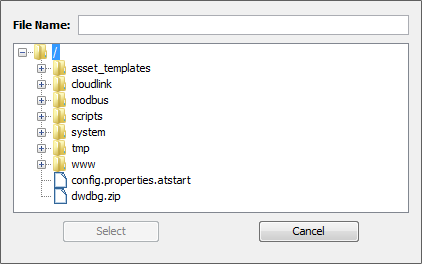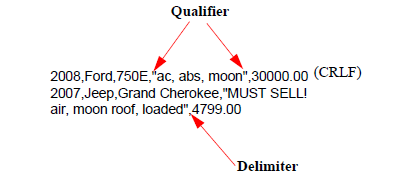The Local DB Import action imports data from a CSV file in the Staging Browser area to a Local Database table.
The data imported from the CSV file is added to the Local Database table. Any existing data already in the Local Database table is not replaced, or overwritten or removed.
For information on exporting and importing the table definition, see Exporting and Importing Local Database tables.
Parameter descriptions
| Parameter | Description |
|---|---|
| Filename | The name of the CSV file that has
the data to import. You can enter the
file name or select
Browse. You must enter
the entire file path and file name. If
you select Browse, the
Staging Browser window appears. For example:  The compound string feature and a substitution variable can be used in the Filename parameter to reference a variable that can be dynamically changed during runtime. For more information, see Using compound strings. For example, entering $(filename) will result in a filename parameter in the Input tab that can reference any variable, whose contents can be changed at runtime. |
| Table | Select the Local Database table
drop-down list. The table must have
been previously been defined. The number of columns and type of data in the CVS file must match the number of columns and type of data in the Local Database table. For example:  |
| Delimiter | The character used to separate the
column values in the CSV file. The
default value is the comma
character. The character to use around text that contains reserved characters such as commas or line breaks. The default value is the double quotation mark ("). |
| Qualifier | The character to use around text
that contains reserved characters such
as commas or line breaks. The default
value is the double quotation mark
("). The following shows example column data from a CSV file whose columns are identified by the qualifier " and each column is delimited by a comma.  Note that CRLF refers to carriage return line feed. |
| First Row is Header | The parameter can be set to
True or
False. Indicates if
the first row in the CSV file is a
header row.
If True, the first
row in the CSV file will be treated as
a header row. In this case, the data
value in each column in the header row
must match a column name in the Local
Database table. It False, the CSV file is consider not to have a header row. The data values from each row in the CSV file are imported into the Local Database table in the same order as the column definition order. |
Output tab

| Parameter | Description |
|---|---|
| Successes | The number of rows that were successfully imported. |
| Failures | The number of rows that could not be imported. |
Local DB Import CSV file considerations
Because legacy systems and enterprise applications that generate CSV files can use varying formats that may or may not conform to any specific standard, the CSV files that are imported should be reviewed for any formatting or discrepancies that might cause import problems.
The Local DB Import action attempts to handle varying formats of CSV files, including support of the following:
- Rows ending with a "/r/n"
- Rows ending without a "/r/n"
- Rows ending with a space
- Rows that contain a percent sign (%)
- Rows that contain a single quote ( ' )
- Rows that begin with an empty value
- Some rows that are separated by carriage returns, some that are not
- Rows that starts with the qualifier ( " )
- Rows that fail to import are handled, and then the importing attempts to continue with the remaining rows
- Row that contains data that represents a TIMESTAMP data type
- Import into a table with an auto-increment column from a CSV file that does not contain the data for the column.